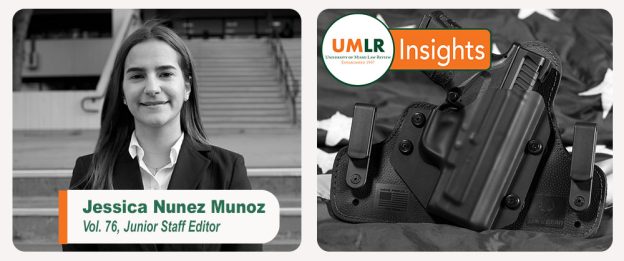JESSICA NUNEZ MUNOZ—In 2008, the Supreme Court in District of Columbia v. Heller held that individuals otherwise qualified to carry handguns have a Second Amendment right to possess guns in their home. In Heller, a District of Columbia law denied a police officer the ability to possess a handgun in his home for self-defense purposes. The Supreme Court struck down the law, interpreting the Second Amendment to mean not that gun ownership is limited to the military, but rather, that “[b]ecause a well-regulated Militia is necessary to the security of a free State,” individuals have a right to gun ownership in the home. Heller did not rule about gun ownership outside the home, but it did discuss limitations that other courts have upheld. Specifically, the Court stated that “the majority of the 19th-century courts to consider the question held that prohibitions on carrying concealed weapons were lawful under the Second Amendment or state analogues.” Because the question was not before the Court, however, the Court chose not to set out the full scope of the Second Amendment.
Since Heller, the Supreme Court had remained silent in major gun control cases. The silence is now over. The Court granted certiorari in New York State Rifle & Pistol Ass’n, Inc. v. Bruen to consider whether a New York law banning citizens from carrying a handgun for self-defense outside the home—unless the citizen shows a “proper purpose”—is constitutional. New York courts have interpreted “proper purpose” to mean “a special need for self-protection distinguishable from that of the general community or of persons engaged in the same profession.”
Petitioners urge the Court to resolve the circuit split over whether concealed carry is a constitutional right by arguing that Heller stands for a broader right of self-defense—both inside and outside the home. They also argue that history shows that the Second Amendment was understood to include the right to gun ownership outside the home. On the other hand, Respondents argue that there is no circuit split because all circuit courts that considered the question have held there is a right to carry firearms outside the home for self-defense purposes—just not an unlimited right. They also argue that history is in their favor because it shows support for certain prohibitions on firearms, like those for convicted felons and in sensitive places like schools.
So, what does this mean for the Second Amendment? Because of former President Trump’s three conservative Supreme Court appointees, some analysts expect that the Court will strike down the New York law and expand gun rights. Specifically, Nina Totenberg, a legal affairs correspondent at NPR, stated that “Justice Neil Gorsuch has weighed in as a strong advocate for gun rights, and if Justices Brett Kavanaugh and Amy Coney Barrett live up to their records as lower court judges, there is now a Supreme Court majority to strongly support gun rights….”
How exactly the Court may choose to support gun rights is a mystery. There are three possible options: (1) the Court may simply strike down the “proper purpose” requirement; (2) it could strike down all laws that give law enforcement discretion to reject concealed carry permits; or (3) it could completely redefine the scope of the Second Amendment to protect the right of gun ownership outside the home for self-defense.
Nonetheless, it is possible, even if improbable, for the Court to rule the other way. The historical record suggests that some regulation of gun possession outside the home has been allowed. Further, some eminent conservative public officials support the New York law, as is evident in the briefs filed by amici. Their position is originalist and it traces from 1328, when England prohibited being armed in public because it disturbed the peace, and to Reconstruction, when the threat of violence from the Ku Klux Klan led to racially neutral gun laws to protect the formerly enslaved.
Regardless of the Court’s decision, the scope of the Second Amendment will be changed.






